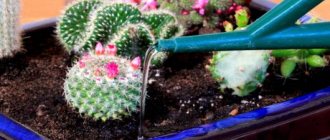Author: Elena N. https://floristics.info/ru/index.php?option=com_contact&view=contact&id=19 Category: Houseplants Published: July 26, 2012Republished: February 25, 2019Last edits: March 19, 2021
We have already talked about caring for azaleas, but separately I would like to discuss such an important issue as replanting azaleas. After your azalea has bloomed, it needs to be replanted, or rather, replanted. When you pull the azalea out of its old pot, you will see that the earthen ball is completely entangled in roots and looks like a washcloth made of soil and small roots, but do not try to clean the azalea roots from the soil, because they replant the azalea at home using the transshipment method. And here's how to do it.
When to replant an azalea at home
Beginner flower growers often wonder when is the best time to replant an azalea. Experts say that this is strictly prohibited in winter. During the dormant period, all processes slow down, buds are formed, and the plant remains in a dormant state. If you replant it, it will negatively affect flowering. It may be completely absent or become too scarce. Transplanting azaleas in winter is a big stress for the crop.
Azalea - a beautiful flowering crop
After the purchase
After purchase, the plant must be carefully inspected. If mold, fungi, or disturbances in the structure of the root system are detected, the plant is replanted in high-quality soil. In this case, you need to get rid of the affected fragments.
After flowering
It is best to move an azalea to a new location in the spring. This is recommended to be done after the flowering period has ended. It is strictly not recommended to carry out the procedure during flowering or bud formation. This usually occurs at the end of June or beginning of August.
Replanting a crop during flowering and budding is possible only in extreme cases. Most often, this procedure leads to the discarding of flowers. A sick azalea may even die.
Important! If you cannot do without replanting, you must first trim the flowers and peduncles. You also need to remove dry branches and foliage to reduce stress on the plant.
Young crops should be replanted every year; adults should be moved to a new location at intervals of 2 years. If the bush has been flooded or the pot has become too small, an unscheduled transplant is carried out.
Complete transplant
From April to the end of summer it is possible to replant azaleas to propagate. Any of the options requires painstaking work. A florist can obtain young plants using cuttings, seeds and by dividing the bush.
Replanting is also done some time after purchasing a new flower. When the plant finishes flowering, it needs to be allocated a new container for growing. And then, over time, it will again turn into a gorgeous tree, the foliage of which is not visible under the flowers.
In general, azaleas should be replanted after purchase.
The procedure is carried out only once and fully. Compliance with the rules will help the plant develop quickly and well. Every year they deal exclusively with transshipment of plants in order to increase the volume of planting capacity. And only if several bushes grow in a pot, they should be planted. Thickening interferes. And diseases that threaten the health of the root system can spread from one shrub to another. In addition, a stronger plant may interfere with the others.
Young plants need replanting once a year, adults - once every 24 - 36 months. Transshipment is carried out not only when the pot has become small, but also if unforeseen circumstances occur.
To plant and even move an azalea, you should know what it looks like and what to do with the lump of earth that is located on the roots. So, a healthy plant should have a lump like a sponge. It cannot be shaken off or cleaned. Thin roots, often located on the surface, can only be separated with a sharp knife and with great care.
It should be remembered that peat soils, which are used to fill special containers for selling and transporting plants, tend to grow to the roots of azaleas. And this greatly interferes with division.
It must be remembered that this rhododendron needs the preservation and presence of its own microflora of the root system. It should be the same throughout the life of the plant. And if an azalea is deprived of this microflora, the bush may even die.
How to properly replant an azalea indoors
Many people are interested in how to properly transplant an azalea at home. To do this, you need to prepare the right pot and soil.
Selection and preparation of soil
How to propagate azalea at home
Azaleas need soil with high acidity parameters. Therefore, it is important to choose the right substrate for the plant. It should be quite loose and allow air to pass well to the root system. To maintain the desired parameters, the plant must be periodically watered with a solution of citric acid.
It is best to make the soil yourself. To do this, you need to take the following ingredients in a ratio of 2:1:1:1:1:
- special substrate for azaleas;
- small tree bark;
- fresh or dry sphagnum moss;
- fine sand;
- charcoal and vermiculite.
You can also mix coniferous soil, peat and sand in a ratio of 2:1:1. A composition based on pine needles, high peat, sand and leaf soil will be no less effective. They are mixed in a ratio of 2:3:1:1.
The prepared substrate must be watered with a special product - “Fitosporin” and its analogues. You can also process the mixture in the oven or steam it over boiling water.
Important! Untreated soil can be a source of pests or fungi that will lead to contamination of the crop. Therefore, the substrate must be disinfected.
You can make soil for azaleas yourself
Selection of pot
The choice of pot for azaleas is of great importance. It should not be very large in size so that the roots feel as comfortable as possible. It is best to choose a container 2 cm larger than the previous one. This will help the root system to settle in faster and minimize the risk of soil flooding.
It is desirable that the pot has low edges and is wide enough. The root system of the plant is characterized by horizontal development, so it requires optimal conditions.
The pot material can be anything. Plastic or ceramic are perfect. At the same time, natural container is still more preferable. There should be drainage holes at the bottom to remove excess moisture.
Renewal root pruning
Carrying out sanitary pruning has a good effect on the condition of the crop. To begin with, the flower with a lump of soil needs to be pulled out of the pot. It must be inspected for external damage and dead fragments removed.
You should not try to separate a dense lump of earth with your hands. This can cause root damage. Before trimming, they need to be soaked in a warm Zircon solution. Then you can carry out renewal pruning. To do this, the roots on each side should be trimmed by 1-1.5 cm.
The roots need to be trimmed a little before transplanting.
Azalea division
By dividing the bush, the plant you like is propagated. Also, the procedure can be carried out due to the impressive size of the bush. How to plant azaleas at home?
To do this, you need to carefully remove the flower from the pot, inspect the roots and, if necessary, trim off diseased or dry fragments. The earthen lump needs to be cut into several fragments.
Important! There must be at least 1 shoot left on each fragment. Each plant needs an individual pot.
Planting in another pot
The step-by-step process of planting a plant looks like this:
- A drainage layer 3 cm thick is poured onto the bottom of the container. It should consist of small stones.
- You need to put wood chips, sand or pine bark on top. The thickness of this layer should be 2 cm.
- Then sprinkle the layer with Trichodermin, which helps to avoid the development of fungi and rot.
- Pour soil on top and distribute evenly throughout the container.
- Remove the azalea from the container with the growth stimulator solution, squeeze out the earth a little and let the liquid drain.
- Place in the center of the prepared soil.
- Sprinkle fresh soil around the azalea. In this case, the root collar of the crop should not be touched.
- Gently add soil to the sides and compact it slightly.
- Lightly water the soil with the solution in which the roots were soaked.
Important! After replanting, it is forbidden to water the bush abundantly. The root system dries more slowly than the soil, so there is a risk of root rot.
Azalea after purchase: risks and necessary measures
To ensure a long and happy indoor life for the flower, the azalea is carefully examined immediately after purchase.
Nurseries producing domestic plants care little about the development of the root system and the further growth of azaleas. Artificially brought to the flowering stage and planted in shipping pots with a small amount of peat mixture, the shrubs are additionally treated with retardants, synthetic substances that put the crop into a kind of sleep. Long-acting fertilizers are added to the soil mixture, a supply of which maintains the freshness and flowering of the plant for 2-3 months. The roots, often damaged during transplantation, do not develop at this time. The plant is at risk of pest and fungal infections.
It is not surprising that when moving from the store to the windowsill, the new pet weakens after a while and may die. The initial inspection of an azalea after purchase is aimed at identifying existing and developing problems and deciding on further actions:
- The peculiarity of azaleas is that a specific microflora is formed around the root system of the plant, the disruption or removal of which threatens problems in growing the crop.
- Equally dangerous is excessive soil moisture, which leads to rotting of the small roots and root collar of the azalea.
If, after purchasing the azalea, problems are discovered with the root system, the condition of the soil is suspicious, there are traces of mold or salinity, it is better to transfer the plant to another container, removing damaged tissue and poor-quality soil.
An azalea covered with flowers or buds should not be replanted. Transferring to another substrate will be a severe or irreparable stress for a culture that spends all its energy on many flowers.
If we are talking about saving a shrub, before replanting it is better to carefully remove most of the blossoming corollas and colored buds.
It is also dangerous to replant an azalea in winter, when the plant is dormant and life processes, including regenerative ones, are inhibited. It is better to try to wait until the growing season resumes and transfer the revived shrub to fresh soil.
Features of transplanting azaleas in the garden
How to replant a cactus: options at home
Transplanting the plant into the garden should be done in early spring - before the active movement of juices. As a last resort, you can replant the crop in early autumn. Street azaleas are characterized by a superficial location of the root system. Therefore, it does not need a deep hole for planting. The depth should not be more than 50 cm, and the width - 70-80.
It is worth considering that the use of lime chips changes the acidity parameters. This negatively affects the development of the bush. When planting, it is worth considering that the root collar of the plant should be above the surface of the earth. After planting, the soil must be compacted and watered.
Azaleas can be planted in the garden
Growing azaleas from seeds
Getting flowering azaleas from seeds is extremely difficult and troublesome, but possible. To do this, small seeds are mixed with dry sand and sown on the surface of the substrate. The best time for the procedure is spring.
Future plants spend three weeks under the film at a temperature of 18–22 °C and constant humidity within 90–100%. They are regularly sprayed and ventilated, preventing drying out or mold. When real leaves form on the seedlings, it’s time for the azaleas to take off. And seedlings that have reached a size of 10–12 cm are transplanted into their own pots.
Typical mistakes during transplantation
Violating the rules for transplanting and caring for azaleas at home can provoke infection with fungi or parasite attacks.
If there is excess moisture, there is a risk of developing rust or root rot. To cope with problems, you need to use any fungicide. A solution of copper sulfate is also suitable. When pests attack, you should immediately treat the bushes with insecticides.
If the azalea does not bloom after transplantation, the cause of the problem may be the following:
- incorrect soil composition;
- improper watering;
- increased air dryness;
- violation of the fertilizer application regime.
Reproduction of azaleas by dividing the bush
In this way, you can propagate an azalea that has many young shoots and a well-developed and healthy root system. The procedure is carried out in the spring, when the crop activates not only its growth, but also its defenses.
Reproduction of azaleas by dividing the bush is risky by damaging the small, but extremely important roots for the plant. Therefore, the procedure should be carried out very carefully using a sharp, disinfected knife.
After being transplanted into their own pots, the separated parts of the azalea regain their strength for at least a year and require special attention and care.
Further flower care
Knowing how to plant azaleas correctly is not enough. The culture needs proper care. It is recommended to treat a weakened plant with growth stimulants. After transplantation, the culture needs optimal conditions:
- Choosing a location. After transplantation, it is recommended to place the azalea in a warm and bright place, protected from direct sunlight. The crop should not be affected by heating sources or drafts. The optimal solution would be a western or northern window.
- Illumination. The culture needs a lot of light. However, it does not tolerate direct rays of the sun. To compensate for the lack of lighting, artificial lighting should be used. In warm weather, you can take the bush to the balcony, slightly shading it.
For lush flowering, the crop requires high-quality care.
- Humidity. The plant needs high humidity. If the air is very dry, you need to pour expanded clay into the pan and pour water. To prevent leaf dryness, azaleas are sprayed every other day.
- Temperature. From October to December, the suitable temperature range is +6-10 degrees. Under such conditions, the process of bud formation proceeds well. As the buds bloom, the temperature is increased to +17 degrees. In summer, the parameters should not be more than +18 degrees. In winter they cannot be less than +5.
- Watering. Potted azaleas need to be watered in the morning. This is done at intervals of 2-3 days. Water should be poured through the tray. After 15 minutes, excess water must be drained.
- Feeding. The azalea should not be fertilized 1-2 months after planting. The procedure provokes a weakening of the culture. As a result, the roots may burn. When the bush recovers, it is fertilized every 2 weeks.
Azalea is a beautiful ornamental plant. In order for the plant to develop normally, it must be replanted periodically. It is important to carry out the procedure correctly.
Description of a beautiful flower
Plants that delight with their beautiful blooms can lift your spirits during the cold season. There are indoor and garden varieties, as well as wild forms of the colorful evergreen azalea. There are also deciduous species.
This shrub performs a decorative function and is one of the most spectacularly blooming. Classified as belonging to the Heather family, the genus Rhododendron, it is presented in many varieties and varieties.
The leaves are elliptical in shape and pubescent. Flowers come in a variety of colors. Terry and two-color varieties have been bred; there are varieties that differ in flowering time.
Usually it is a shrub from 25 to 150 cm in height. There are up to 10 indoor varieties known that feel good in Russian apartments.
Azalea - flowering rhododendron: description of the species
Azalea is a plant from the genus Rhododendron of the heather family. Two varieties are suitable for growing indoors:
- Indian - in indoor conditions it grows from 40 to 60 cm. It forms funnel-shaped flowers, collected in inflorescences of 2-3 pieces. The formation and opening of buds continues from December to May. When other indoor plants are at rest.
- Japanese - most often grown in open ground, but cultivation at home is also possible. The height of the indoor plant is from 30 to 50 cm. Flowers, depending on the variety, reach from 2.5 to 7.5 cm in diameter. There are simple, terry or semi-double.
Azaleas of any variety form a compact bush with short shoots and densely spaced oval, dark green leaves. Based on the time of bud formation, plants are divided into 3 groups:
- early flowering – December-January;
- average flowering period - January-February;
- late flowering - February-March.
Indian azalea: indoor plant
The flowers are quite large - up to 5 cm of various colors, they can be simple, double, corrugated or not. This species is the ancestor of most indoor azaleas. Interesting fact: all the flowers on the plant open at the same time. By choosing the right varieties, you can achieve constant flowering.
Indian azalea flower: photo
Japanese azalea
A rarer species for indoor floriculture. The flowers are smaller than those of the Indian azalea, but it can be planted in open ground.
Japanese azalea flowers: photo
Azalea pruning
Pruning your azalea is essential. The intensity of its flowering depends on timely pruning. A large amount of green mass on the shoots will be an obstacle to the formation of buds. Azaleas need to be pruned every spring after flowering.
Take a sharp knife or pruning shears. Disinfect them with alcohol. First, you need to trim long shoots, the length of which exceeds the average length of all shoots, then densely growing shoots should be pruned. If your azalea has weak, poorly growing shoots, they can also be removed. The more branches you cut, the better they will be covered with greenery. The main thing is not to overdo it, common sense should always be present. After trimming, disinfect the cut areas with RanNet paste. After pruning, new leaves will appear within a few weeks.
Using pruning, you can form a crown; the most attractive is considered to be a spherical crown with a bare trunk (ideally, if everything is done in a timely and correct manner, the azalea will look like a miniature tree). After pruning, leave the azalea alone for a short time before replanting (if required).
If you have a young specimen, it is better to start forming the crown from an early age.
And we gradually got to the most difficult part. This is an azalea transplant after flowering.











